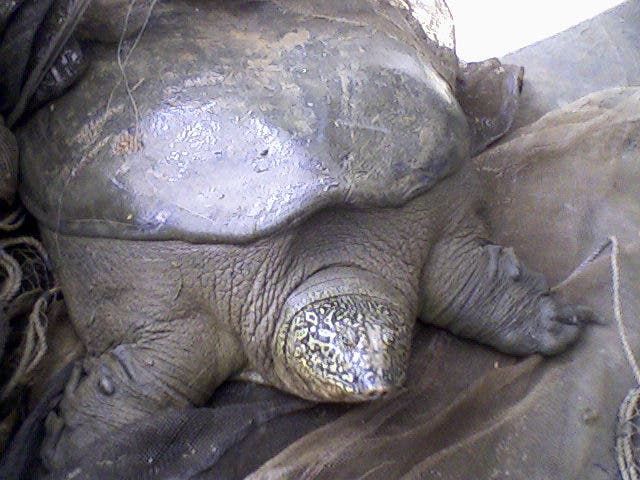A female Yangtze giant softshell turtle (quite possibly the last female of her species) has been given another chance to breed. She has been artificially inseminated at the Suzhou Zoo in China, in a last ditch effort to attempt to preserve her species.

The Yangtze giant softshell turtle (Rafetus swinhoei) is the largest freshwater turtle in the world. It measures over 100 cm (39 in) in length and 70 cm (28 in) in width, and weighs about 70–100 kg (150–220 lb). Unfortunately, it may be going extinct in only a few years; only 4 known individuals survive today, and only one female. All breeding efforts have remained unsuccessful, despite initial optimism.
But biologists didn’t give up – they decided to use technology and give the species another chance, as desperate as it might be.
“We had to find out if the last known male in China no longer produces viable sperm due to old age or an inability to inseminate the female,” said Dr. Gerald Kuchling, organizer of the artificial insemination effort and Rafetus breeding program leader for the TSA.
As it turned out, the male turtle actually had damaged sexual organs, likely due to a fight that took place decades ago. For this reason, scientists believe, he was incapable of actually inseminating the female, despite intercourse taking place. So they went for artificial insemination.
“Normal semen parameters for Rafetus are unknown as this was the first attempt to collect and examine sperm from this species,” said Dr. Barbara Durrant, Director of Reproductive Physiology at the San Diego Zoo Institute for Conservation Research. “The semen evaluation revealed that approximately half of the sperm were motile.”
This is the first time any insemination was done with a freshwater turtle, but it’s still too soon to tell if the attempt was successful.
“This was a great exploration to advance the conservation of Rafetus swinhoei, however, we can not yet determine if the exploration was successful or not,” said Director Chen Daqing of Suzhou Zoo. The female will lay the eggs in a few weeks and in a couple of weeks after that, the scientists will know if the eggs are fertile.
In the meantime, the team has little to do other than wait and see what happens.
“The conservation world will once again be holding its collective breath until we know if this was successful,” Fort Worth Zoo Biologist and Turtle Survival Alliance President Rick Hudson said. “The optimism we felt back in 2008 when the pair was mating and laying eggs has slowly faded as reality sank in that this pair would not breed without intervention.”
But even if the attempt is successful, bringing the species back from the brink of extinction is an uphill battle. Because there are so few individuals, the species will experience what is called a genetic bottleneck, which translates into very low genetic diversity, and in consequence, the robustness of the population is reduced and its ability to survive selecting environmental changes, like climate change or a shift in available resources, is reduced. But it’s a valiant effort, and it has a chance to work. I’m all for it!
Was this helpful?



